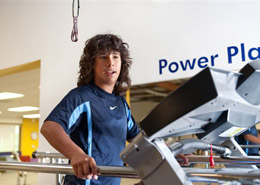
With physical therapy at Rady Children’s, Jose continues to improve.
Life changed literally overnight for 14-year-old Jose Alejandro Estrada in February of 2008.
An active teenager who played soccer dodge ball and has a black belt in taekwondo, Jose went to bed one evening feeling fine and woke up the next morning in excruciating pain.
“He woke up saying his legs felt like they were burning up,” said Mariana Estrada, Jose’s mom. “We couldn’t get him up out of bed. He was in too much pain, so we had to call an ambulance.”
Within a few hours of arriving at Rady Children’s Hospital-San Diego, Jose was paralyzed from the waist down.
His parents couldn’t recall any traumatic injuries or falls in the preceding days. He hadn’t complained of any pain. He had no symptoms.
After being given a full battery of tests to determine what had caused the pain and subsequent paralyzation, he was diagnosed with transverse myelitis, a neurological disorder of the spine caused by inflammation. Jose was told that he would probably never walk again.
“Jose went from being a healthy active teenager to receiving a devastating diagnosis in a matter of hours,” says Dr. Adam Breslow, pediatrician with Children’s Primary Care Medical Group. “It all happened so amazingly quickly, and, unfortunately, we couldn’t provide much encouragement to Jose and his family in those first few days.”
Transverse myelitis is unusual, but not unheard of. The National Institute for Neurological Disorders and Stroke estimates that about 1,400 new cases of transverse myelitis are diagnosed each year in the United States.
Doctors generally cannot pinpoint its exact cause, as in Jose’s case, but it is believed to be associated with either viral infections, abnormal immune reactions, or insufficient blood flow through the blood vessels located in the spinal cord.
When he was first told that he was paralyzed and probably wouldn’t walk again, Jose didn’t believe it. He’s a tenacious teenager who decided that the doctors were wrong. He was confident from those first moments that he would, in fact, walk again.
Hospitalized for two months, Jose was first given high doses of steroids to decrease the spinal inflammation. It took more than a week before doctors noted much improvement and Jose was able to move his toes.
Those first movements of his toes, provided hope that he would be able to walk again someday.
Mariana remembers thinking that once he was admitted to the hospital and started on medications that Jose would be better in a matter of days. When that didn’t happen, she and her husband, Ricardo, began to fear for the worst.
Jose’s family channeled that fear into assuring that Jose received the care and therapies that his body needed to get better. Spending nearly every day of Jose’s hospitalization by his side, his mom, dad and younger brother, Ricky, were instrumental in keeping the lines of communication open and pushing doctors and therapists to try anything and everything possible to help him walk again.
“It was a massive undertaking to help Jose get better,” says Breslow. “From the moment to moment heroics in the Intensive Care Unit to the nursing and rehab teams, occupational therapy, physical therapy, dieticians and so many more, there were a lot of people who worked together to make him better. But a lot of the credit for him walking again goes to Jose and his family.”
Jose credits the staff and friends he made at Rady Children’s for helping him fight so hard to get better.
“After that long in the Hospital, most people want to leave and go home,” says Ricardo, Jose’s dad. “But not him, he made really good friends and didn’t want to leave. The people at the hospital became like a second family.”
Today, more than 18 months after his initial hospitalization, Jose can walk with assistance. He attends therapy sessions three days a week and has acupuncture treatments once a week. After missing one year of school, he was thrilled to recently return to school with his classmates at Montgomery High School.
An aspiring artist, he credits drawing with keeping him entertained in the Hospital.
The San Diego Union-Tribune Kids’ NewsDay, October 2009